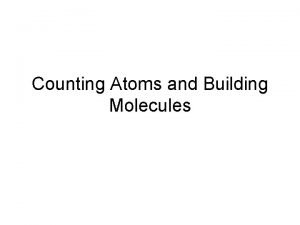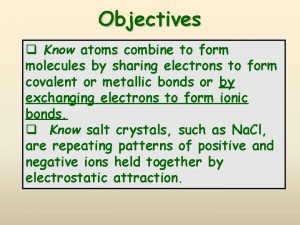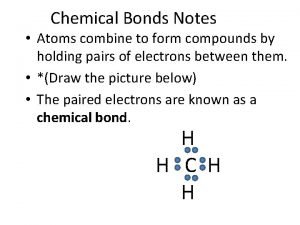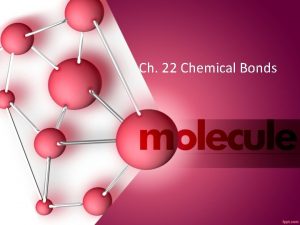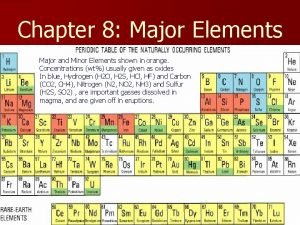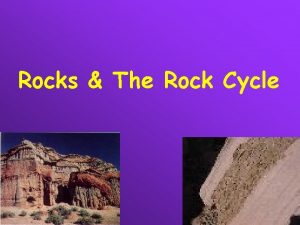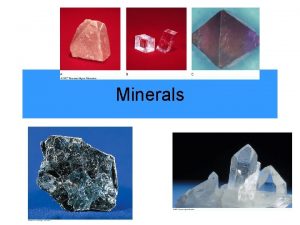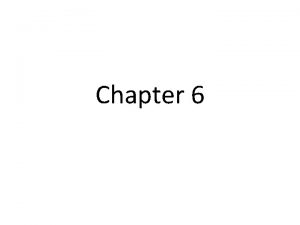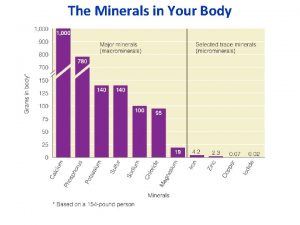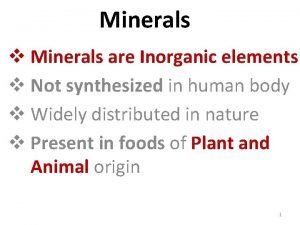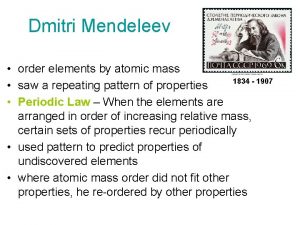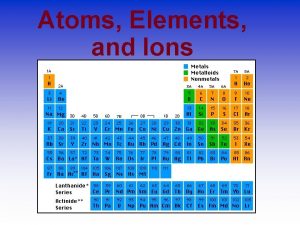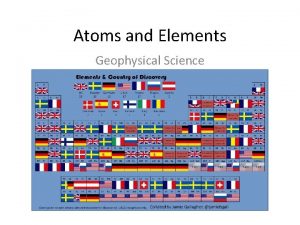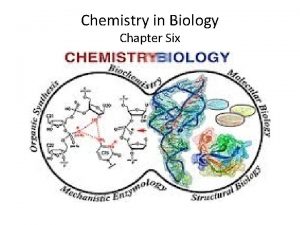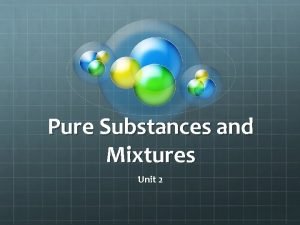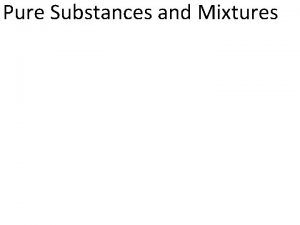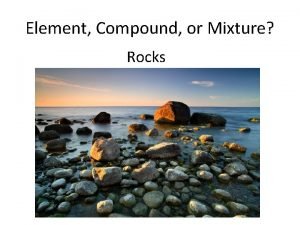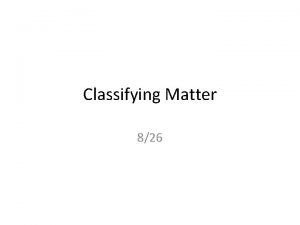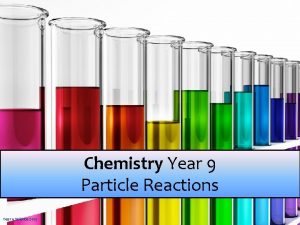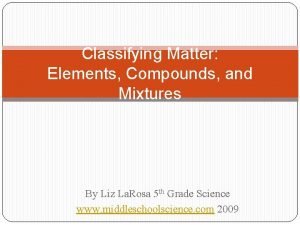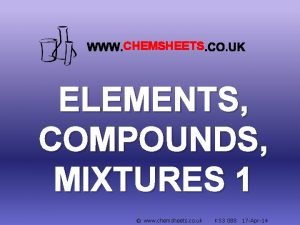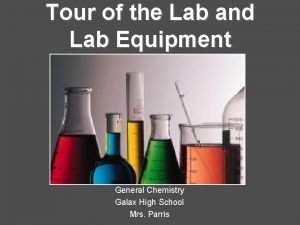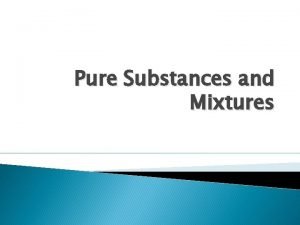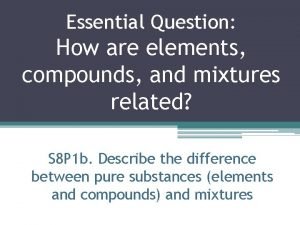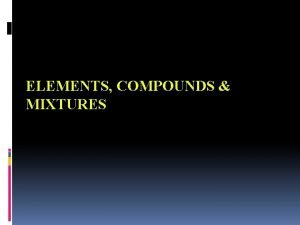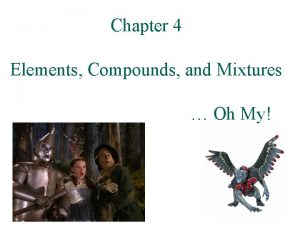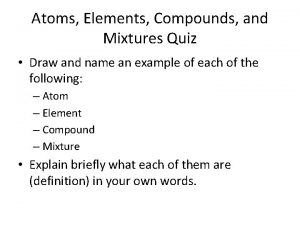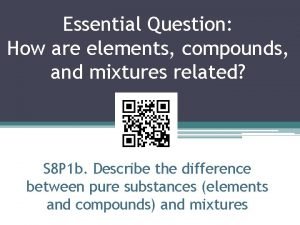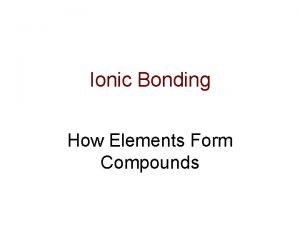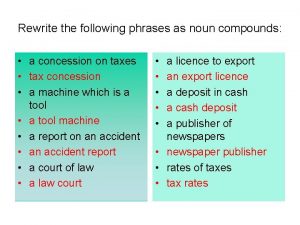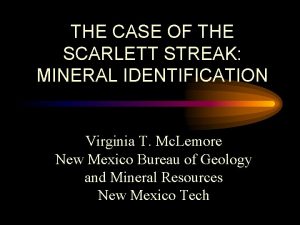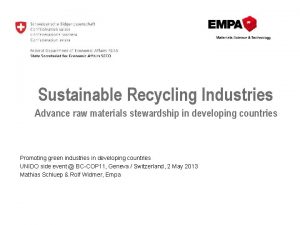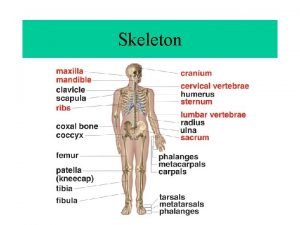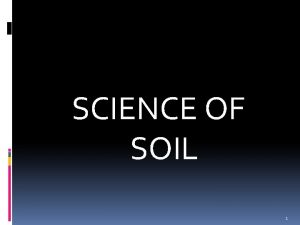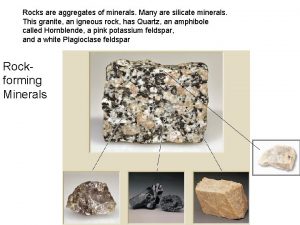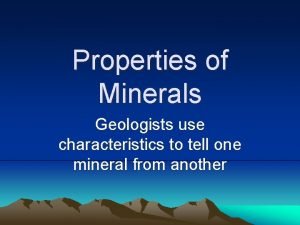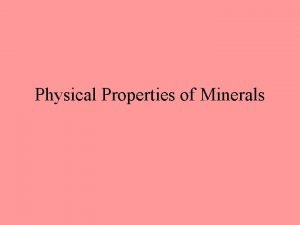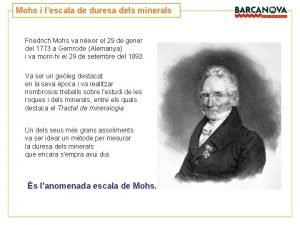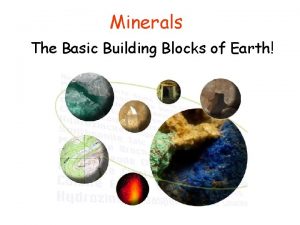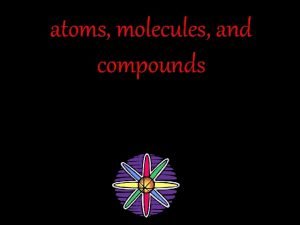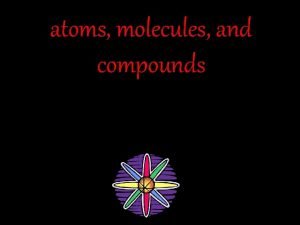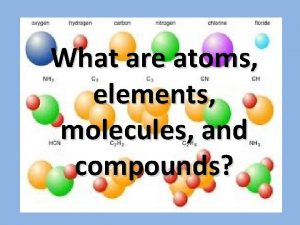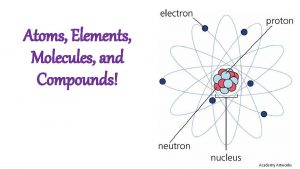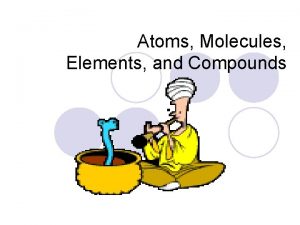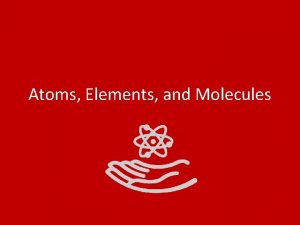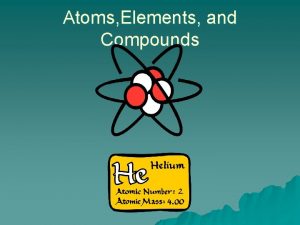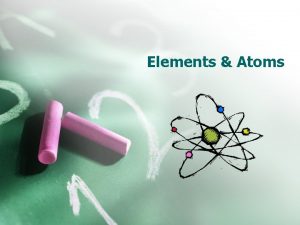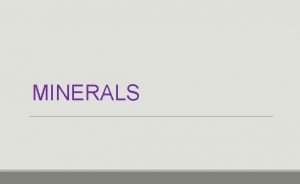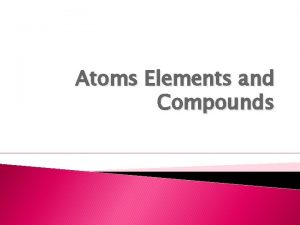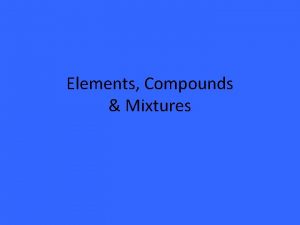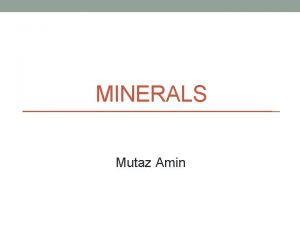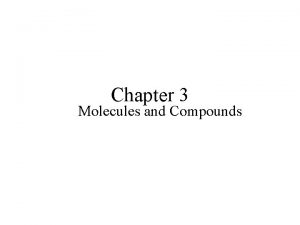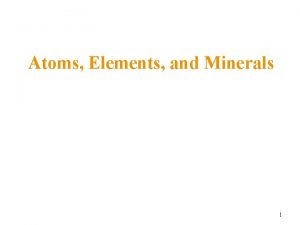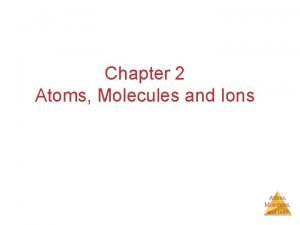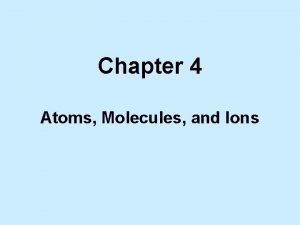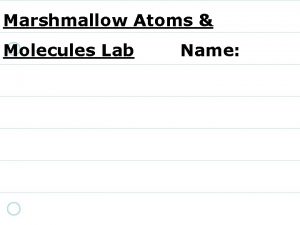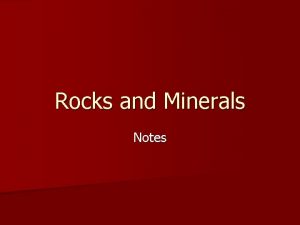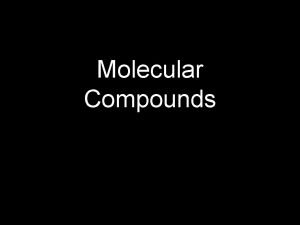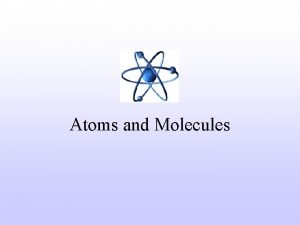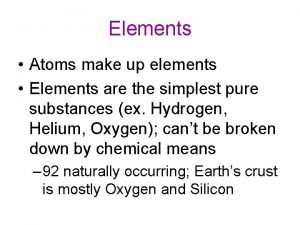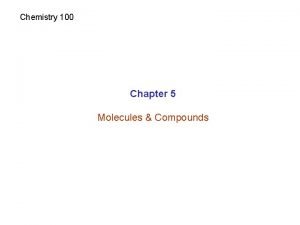Atoms elements make Molecules compounds make Minerals make






























































- Slides: 62


Atoms (elements) make Molecules (compounds) make Minerals make Crystals Minerals are inorganic solids

GARNET TALC PYRITE WOLLASTONITE MICA DOLOMITE HALITE


Cannot test properties of ROCKS. Defined by environment of formation. Igneous Rocks Formed from cooled and solidified lava or magma.


Sedimentary Rocks Made from layers of sediments of other rocks or living organisms.


Metamorphic Rocks



Which rock-forming mineral is composed of two elements. One of the elements makes up 46. 10% and the other makes up 5. 63% of Earth’s crust by mass respectively? 1) Galena 2) Quartz 3) Halite 4) Magnetite

Both Samples A and D exhibit crystals. How are they different? n w o r g r e t n i s a h D ! ! e ! l ! p s l m a t Sa s y cr

Which sequence of change in rock type occurs as shale is subjected to increasing heat and pressure? (1) shale → schist → phyllite → slate → gneiss (2) shale → slate → phyllite → schist → gneiss (3) shale → gneiss → phyllite → slate → schist (4) shale → gneiss → phyllite → schist → slate

The data table shows the density of four different mineral samples. Corundum has a hardness of 8 on Moh’s hardness scale. In order the hardness of these mineral’s is (1) galena, hematite, quartz, and corundum (2) quartz, hematite, galena, and corundum (3) galena, corundum, quartz, and hematite (4) galena, hematite, corundum, and quartz

What is a possible classification for Rock type A? IGNEOUS 8/03

What is a possible classification for texture B? NON-FOLIATED

What rocks may D & E refer to? (1) Pegmatite & Limestone (3) Hematite & Pumice (2) Scoria & Slate (4) Dunite & Breccia

Which two processes lead directly to the formation of both schist and marble? (1) melting and solidification (2) evaporation and precipitation (3) compaction and cementation (4) heat and pressure

What is the origin of fine-grained igneous rock? (1) lava that cooled slowly on Earth’s surface (2) lava that cooled quickly on Earth’s surface (3) silt that settled slowly in ocean water (4) silt that settled quickly in ocean water

The photograph shows an igneous rock. What is the origin and rate of formation of this rock? (1) plutonic with slow cooling (2) plutonic with rapid cooling (3) volcanic with slow cooling (4) volcanic with rapid cooling

These strata represent ancient history. Many millions of years ago a layer of siltstone and a layer of limestone were “intruded” by a felsic magma that cooled into granite. The granite intrusion caused metamorphism to part of the limestone. What metamorphic rock would be found in this zone of contact metamorphism? (1) marble (3) gabbro (2) quartzite (4) slate

Base your answers to the questions on the flowchart, which shows a sequence of geologic processes at or near Earth’s surface. Box A has been deliberately left blank. The diagrams are not drawn to scale. Identify the three minerals that are normally found with quartz in samples of andesite rock. Plagioclase Feldspar Biotite Amphibole Pyroxene

State one geologic process represented by box A. Uplift Weathering Erosion

Identify by name one type of rock layer, other than sandstone, shown in the outcrop. Siltstone Conglomerate Limestone

Soil that contains large quantities of calcium was most likely formed by the weathering of (1) rock salt (3) coal (2) quartzite (4) limestone

The graph at left shows the hardness of four minerals. Which is hard enough to scratch calcite but NOT hard enough to scratch amphibole? (1) muscovite mica (2) fluorite (3) olivine (4) graphite

Which two minerals have cleavage planes at right (90 o) angles? (1) (2) (3) (4) Biotite Mica and Muscovite Mica Sulfur and Amphibole Quartz and Calcite Feldspar and Pyroxene

The data table shows the density of four different mineral samples. A student accurately measured the mass of a sample of one of the four minerals to be 294. 4 g and its volume to be 73. 6 cm 3. Which mineral sample did the student measure? (1) corundum (3) hematite (2) galena (4) quartz

Which intrusive igneous rock could be composed of approximately 60% pyroxene, 25% plagioclase feldspar, 10% olivine, and 5% amphibole? (1) granite (3) gabbro (2) rhyolite (4) basalt

Which igneous rock is probably best described as being non-vesicular and mafic? (1) andesite (3) gabbro (2) pegmatite (4) obsidian

The diagram below shows four rock samples. Which sample best shows the characteristics normally associated with igneous rocks? (1) A (3) C (2) B (4) D Intergrown crystals

A geologist found a large quantity of mineral ore. The mineral exhibited fracture, was harder than glass, and had a metallic luster. The mineral is probably composed mostly of (1) Na. Cl (2) Fe. S 2 (3) Si. O 2 (4) Pb. S Pyr ite!

Some of the bedrock in Vermont’s Green Mountains is actually green in color due to the presence of the mineral chlorite. Which other mineral can cause rocks to appear green? (1) sulfur (3) olivine (2) magnetite (4) halite

Which property is most useful in distinguishing pyroxene from amphibole? (1) sample size (2) hardness (3) type of luster (4) angles of cleavage

The table below shows some properties of four different minerals. The minerals in the table are varieties of which mineral? (1) garnet (3) quartz (2) magnetite (4) olivine

Which three minerals contain high concentrations of the element Calcium (Ca)? (1) Sulfur, Fluorite, & Plagioclase (2) Talc, Pyrite, & Muscovite (3) Calcite, Amphibole, & Dolomite (4) Potassium Feldspar, Halite, & Garnet

A series of layers (strata) of sedimentary rock have been deposited over millions of years, as shown in the diagram to the right. If magma pushes its way to the surface, and heats rocks along the way, many of these rocks will melt. The rest will not melt however, and will instead undergo a contact metamorphism. How about here? Quartzite! Which rock will be created in the contact metamorphic zone here? Marble!

Under which crustal temperature and pressure conditions will andalusite form? (1) 300°C and 6000 atmospheres (2) 600°C and 4000 atmospheres (3) 500°C and 2000 atmospheres (4) 700°C and 8000 atmospheres

Which graph correctly represents the three most abundant elements, by mass, in Earth’s crust?

Rocks cannot be identified by physical properties like minerals can. This is principally due to 1) The variety of minerals of differing properties that make them 2) The difference between the hardness of their forms 3) Their lack of properties 4) The manner in which their environment of formation effects them

Which processes formed the igneous rock granite that is mined in Vermont? (1) compaction and cementation of sediments (2) cooling and solidification of magma (3) uplift and weathering of bedrock (4) application of heat and pressure to shale

Which rock was organically formed and sometimes contains fossilized plant impressions? (1) rock gypsum (3) breccia (2) phyllite (4) coal

In addition to ash, solid rock formed on Mt. Hekla from the lava extruded during an eruption. This rock is most likely Mt. Hekla (1) light-colored metamorphic (2) fine-grained igneous (3) dark-colored metamorphic (4) coarse-grained igneous

Base your answer on the drawings of six sedimentary rocks labeled A through F. Which table shows the rocks correctly classified by texture?

k n i Th ? t i t go e What is the approximate % of v ’ u yo Plagioclase Feldspar in a typical Andesite?


ID the mineral by following these steps: 1. Record the name of the mineral property being tested. 2. Record the result of each property test. 3. “Key” the mineral out with the key below.

Hardness result

Luster result

Fracture/Cleavage result Fracture

Streak result

Click me to see video of it! Correct Symbol? 3

Rock outcrop 1 contains 4 strata of sedimentary rock. Which strata is composed of sediments that are 0. 08 cm? (1) 1 (2) 2 (3) 3 (4) 4




The minerals talc, muscovite mica, quartz, and olivine are similar because they (1) have the same hardness (2) are the same color (3) contain silicon and oxygen (4) break along cleavage planes

The diagram represents a sample of mineral A. Mineral A is most likely (1) garnet (3) olivine (2) galena (4) halite

Which mineral can scratch A, B, and C, but can not scratch D ? (1) talc (2) selenite gypsum (3) fluorite (4) quartz

The most abundant metallic element by mass in Earth’s crust makes up 8. 23% of the crust. Which group of minerals all normally contain this metallic element in their compositions? (1) garnet, calcite, pyrite, and galena (2) biotite mica, muscovite mica, fluorite, & halite (3) talc, quartz, graphite, & olivine (4) plagioclase feldspar, amphibole, pyroxene, & potassium feldspar

These strata may all be classified as 1) Igneous 3) Metamorphic 2) Sedimentary 4) Felsic Which outcrop contains a strata rich in calcite? 1) I 3) Both I and II 2) II 4) neither The difference between the three strata in outcrop II is 1) density 3) fragment sizes 2) color 4) mineral composition Rock outcrops I and II each show three strata of rock, some of which contain fossils.
 Mixture of elements
Mixture of elements Section 1 atoms elements and compounds
Section 1 atoms elements and compounds Chapter 6 section 1 atoms elements and compounds answer key
Chapter 6 section 1 atoms elements and compounds answer key Chapter 6 section 1 atoms elements and compounds
Chapter 6 section 1 atoms elements and compounds Organic molecules vs inorganic molecules
Organic molecules vs inorganic molecules Relationship between atoms and molecules
Relationship between atoms and molecules How can you count atoms and molecules
How can you count atoms and molecules Ion chapter 11
Ion chapter 11 Atoms molecules and ions
Atoms molecules and ions Atoms molecules and ions
Atoms molecules and ions Atoms molecules and ions
Atoms molecules and ions Atoms ions and molecules
Atoms ions and molecules Atoms ions and molecules
Atoms ions and molecules Atoms combine to form
Atoms combine to form Collision theory states that
Collision theory states that Chapter 2 atoms molecules and ions
Chapter 2 atoms molecules and ions Compared to atoms of metals, atoms of nonmetals generally
Compared to atoms of metals, atoms of nonmetals generally All compounds are molecules
All compounds are molecules Molecules vs compounds
Molecules vs compounds Atoms combine to form compounds
Atoms combine to form compounds Is o2ionic or covalent
Is o2ionic or covalent Venn diagram of ionic covalent and metallic bonds
Venn diagram of ionic covalent and metallic bonds Major elements
Major elements Quartzite rock cycle
Quartzite rock cycle Minerals vs elements
Minerals vs elements Elements are moved between minerals during metamorphism by:
Elements are moved between minerals during metamorphism by: Enzim
Enzim Iron deficiency anemia smear
Iron deficiency anemia smear M in periodic table
M in periodic table Which elements exist as diatomic molecules
Which elements exist as diatomic molecules Li atomic mass
Li atomic mass Www.chem.purdue/gchelp/atoms/elements.html
Www.chem.purdue/gchelp/atoms/elements.html How are the particles that make up atoms diagrammed
How are the particles that make up atoms diagrammed Elements compounds and mixtures 1 worksheet answers
Elements compounds and mixtures 1 worksheet answers Honey homogeneous or heterogeneous
Honey homogeneous or heterogeneous Elements, compounds and mixtures worksheet with answers
Elements, compounds and mixtures worksheet with answers Rocks element compound or mixture
Rocks element compound or mixture Elements and compounds examples
Elements and compounds examples Elements and compounds examples
Elements and compounds examples Periodic table mixtures
Periodic table mixtures Types of matter elements compounds and mixtures
Types of matter elements compounds and mixtures Elements and compounds
Elements and compounds Used for heating of stable solid compounds and elements
Used for heating of stable solid compounds and elements Mixtures images
Mixtures images Study jams elements and compounds
Study jams elements and compounds Types of homogeneous mixture
Types of homogeneous mixture What elements combine to make propane
What elements combine to make propane Elements compounds and mixtures oh my worksheet
Elements compounds and mixtures oh my worksheet Elements compounds and mixtures quiz
Elements compounds and mixtures quiz Elements and compounds study jams
Elements and compounds study jams How elements form compounds
How elements form compounds Compound noun phrase
Compound noun phrase Streak of minerals
Streak of minerals Conflict minerals
Conflict minerals Storage of minerals
Storage of minerals Primary vs secondary minerals
Primary vs secondary minerals Rocks are aggregates of minerals
Rocks are aggregates of minerals Types of rocks
Types of rocks Rock cycle
Rock cycle Cleavage minerals
Cleavage minerals Properties of minerals
Properties of minerals Pirita duresa
Pirita duresa The building block of the silicate minerals is _____.
The building block of the silicate minerals is _____.






